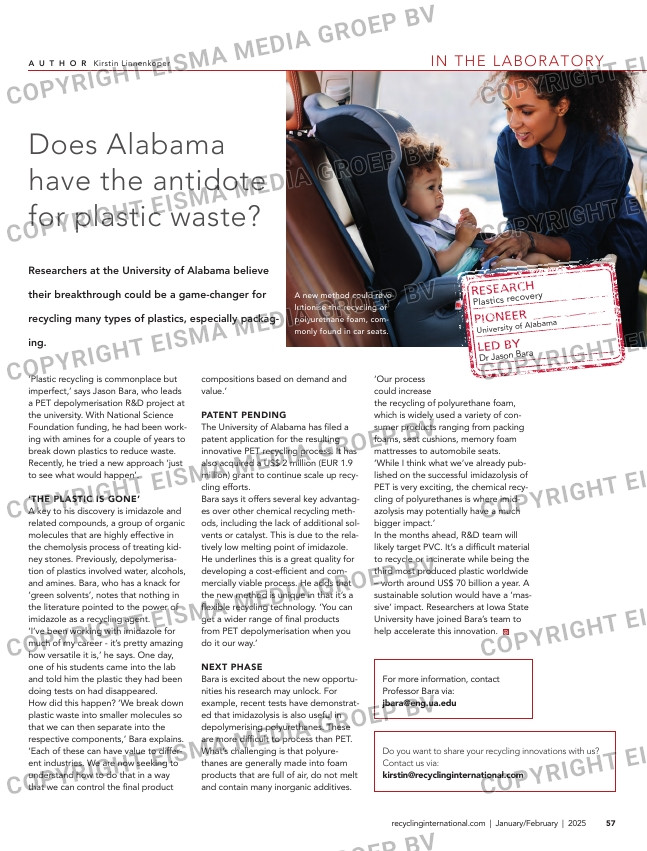Page 57 from: Recycling International Jan/Feb 2025

IN THE LABORATORY
57recyclinginternational.com | January/February | 2025
Does Alabama
have the antidote
for plastic waste?
Researchers at the University of Alabama believe
their breakthrough could be a game-changer for
recycling many types of plastics, especially packag-
ing.
‘Plastic recycling is commonplace but
imperfect,’ says Jason Bara, who leads
a PET depolymerisation R&D project at
the university. With National Science
Foundation funding, he had been work-
ing with amines for a couple of years to
break down plastics to reduce waste.
Recently, he tried a new approach ‘just
to see what would happen’.
‘THE PLASTIC IS GONE’
A key to his discovery is imidazole and
related compounds, a group of organic
molecules that are highly effective in
the chemolysis process of treating kid-
ney stones. Previously, depolymerisa-
tion of plastics involved water, alcohols,
and amines. Bara, who has a knack for
‘green solvents’, notes that nothing in
the literature pointed to the power of
imidazole as a recycling agent.
‘I’ve been working with imidazole for
much of my career – it’s pretty amazing
how versatile it is,’ he says. One day,
one of his students came into the lab
and told him the plastic they had been
doing tests on had disappeared.
How did this happen? ‘We break down
plastic waste into smaller molecules so
that we can then separate into the
respective components,’ Bara explains.
‘Each of these can have value to differ-
ent industries. We are now seeking to
understand how to do that in a way
that we can control the final product
compositions based on demand and
value.’
PATENT PENDING
The University of Alabama has filed a
patent application for the resulting
innovative PET recycling process. It has
also acquired a US$ 2 million (EUR 1.9
million) grant to continue scale up recy-
cling efforts.
Bara says it offers several key advantag-
es over other chemical recycling meth-
ods, including the lack of additional sol-
vents or catalyst. This is due to the rela-
tively low melting point of imidazole.
He underlines this is a great quality for
developing a cost-efficient and com-
mercially viable process. He adds that
the new method is unique in that it’s a
flexible recycling technology. ‘You can
get a wider range of final products
from PET depolymerisation when you
do it our way.’
NEXT PHASE
Bara is excited about the new opportu-
nities his research may unlock. For
example, recent tests have demonstrat-
ed that imidazolysis is also useful in
depolymerising polyurethanes. These
are more difficult to process than PET.
What’s challenging is that polyure-
thanes are generally made into foam
products that are full of air, do not melt
and contain many inorganic additives.
‘Our process
could increase
the recycling of polyurethane foam,
which is widely used a variety of con-
sumer products ranging from packing
foams, seat cushions, memory foam
mattresses to automobile seats.
‘While I think what we’ve already pub-
lished on the successful imidazolysis of
PET is very exciting, the chemical recy-
cling of polyurethanes is where imid-
azolysis may potentially have a much
bigger impact.’
In the months ahead, R&D team will
likely target PVC. It’s a difficult material
to recycle or incinerate while being the
third most produced plastic worldwide
– worth around US$ 70 billion a year. A
sustainable solution would have a ‘mas-
sive’ impact. Researchers at Iowa State
University have joined Bara’s team to
help accelerate this innovation.
Do you want to share your recycling innovations with us?
Contact us via:
[email protected]
For more information, contact
Professor Bara via:
[email protected]
A U T H O R Kirstin Linnenkoper
RESEARCH
PIONEER __
_________
LED BY
Plastics recov
ery
Dr Jason Bara
University of A
labama
A new method could revo-
lutionise the recycling of
polyurethane foam, com-
monly found in car seats.
57_inthelab.indd 57 29-01-2025 11:35



